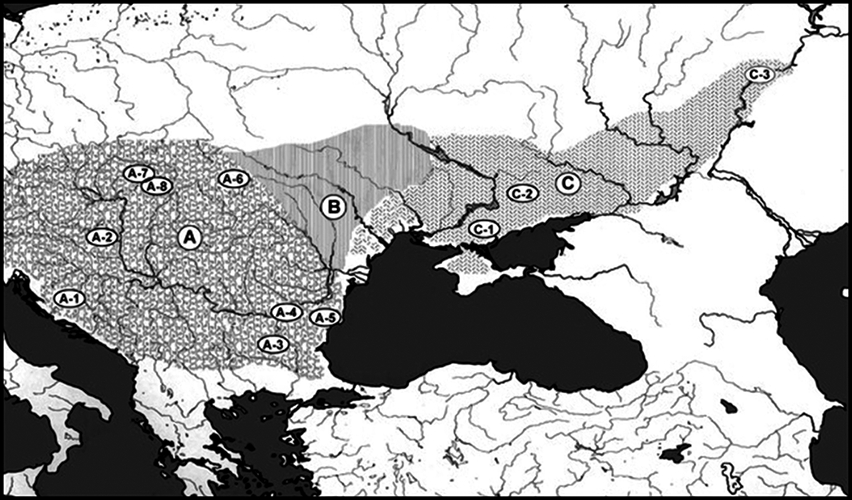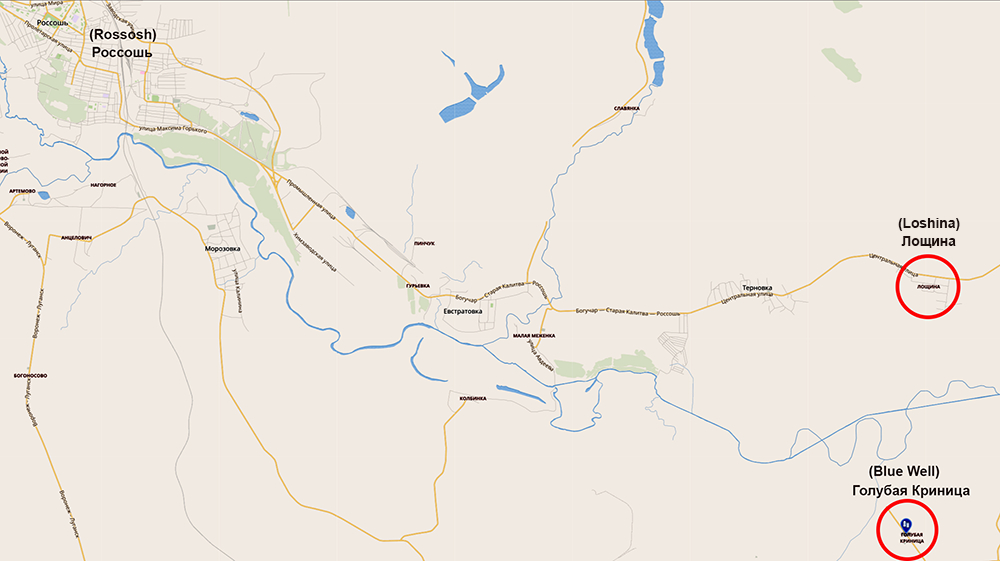Back to Don's Maps
Rossosh burial mounds
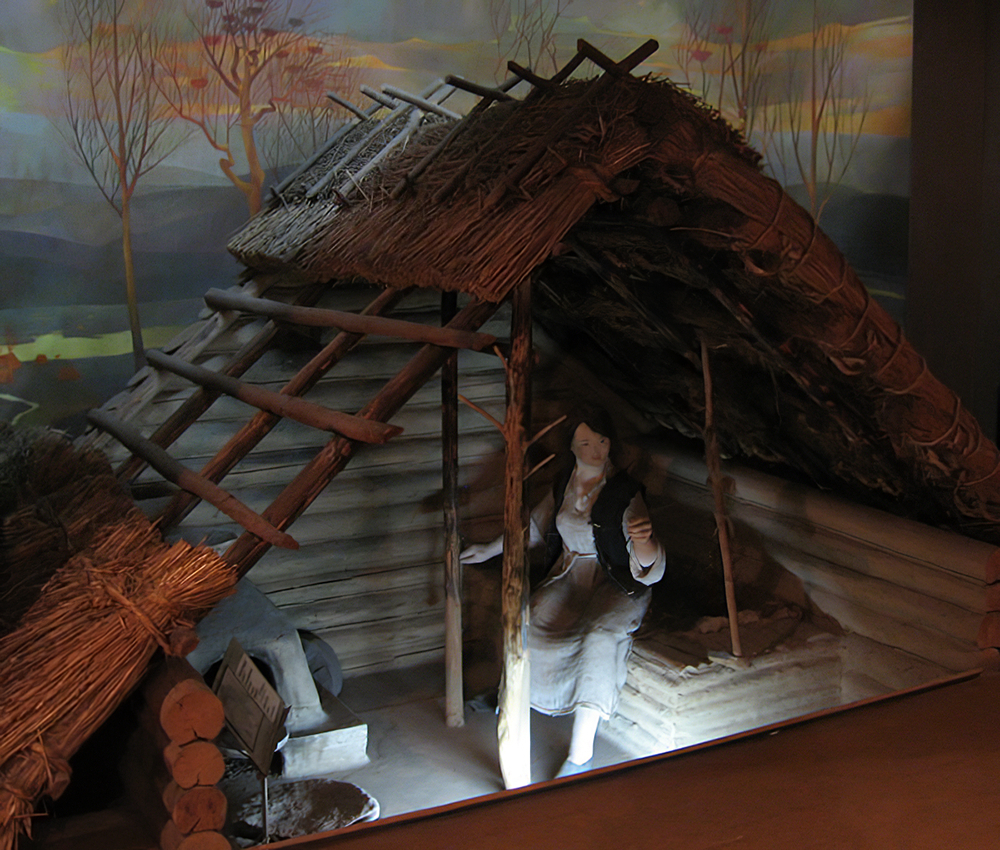
A hut of the Srubnaya culture, as reconstructed in the Ternopil Museum of Regional Ethnography.
Photo and text: Russian Wikipedia user Водник
Permission: GNU Free Documentation License
The Srubnaya culture, also known as the Log house culture, or the Timber-grave culture, was a Late Bronze Age (18th–12th centuries BC) culture in the eastern part of Pontic-Caspian steppe. It is a successor to the Late Catacomb culture and the Poltavka culture, as well as the Potapovka culture.Text above: Wikipedia
In 1902 the archaeologist V. A. Gorodtzov, on the basis of his excavations, suggested that the most ancient peoples of the northern shores of the Black Sea could be divided into three cultures, according to the strikingly different ways in which they built their tombs: the pit-grave culture, the catacomb-grave culture, and the timber-grave culture. This theory has been supported and made more precise by later archaeological work. The tombs of the catacomb culture date from the beginning and middle of the second millennium B.C.; they belonged to a Bronze Age people with a developed bronze metallurgy, whose economy was based on semi-nomadic cattle-breeding and agriculture. They had already established relations with other cultures. In the middle of the second millennium B.C., the catacomb people were replaced on the north shore of the Black Sea by the timber-grave people, whose tombs were built like log cabins. This culture had developed to the east, in the region around the Volga river and the southern Urals, and had spread over a vast territory, remaining in existence until the mid-eighth century B.C. Again, its characteristics were a highly developed bronze metallurgy and semi-nomadic cattle-breeding, but with special emphasis on horse-breeding. Recent studies have convincingly suggested that the Cimmerians represent tribes of a late stage of the timber-grave culture; they were well-armed horsemen who could move easily over long distances.Text above: Piotrovsky (1973)

Map of the Scythian core region and territories of their possible influences in 7th–3rd century BC.
Locations of sites investigated are marked as red stars: Glinoe (1), Vapnyarka (2), Nesterivka (3), Svetlovodsk (4), Starosillya (5), Simferopol (6). Colored circles show locations of comparative ancient populations. Population abbreviations: SCR, Scythians from Russia; SRU, Srubnaya culture; YAM, Yamnaya culture; HBA, Bronze Age populations from Hungary; RBA, Bronze Age populations from Russia; HGE, Hunter-Gatherers Eastern; HGN, Hunter-Gatherers Northern; HGW, Hunter-Gatherer Western; BBC, Bell Beaker culture; CWC, Corded Ware culture; UNC, Unetice culture; NEN, Near Eastern Neolithic; LBK, Linear Pottery culture; LDN, Late Danubian cultures; MNE, Middle Neolithic cultures.
( note that the incidence of the Srubnaya, Yamnaya, and Corded Ware cultures extended north from the areas shown in this map, well into present day Russia - Don )
Photo and text: Juras et al. (2017)
The Yamnaya culture (Ямная культура), also known as the Yamna culture, Pit Grave culture, or Ochre Grave culture, was a late Copper Age to early Bronze Age archaeological culture of the region between the Southern Bug, Dniester, and Ural rivers (the Pontic steppe), dating to 3300–2600 BC. Its name derives from its characteristic burial tradition: kurgans containing a simple pit chamber.Text above: Wikipedia
The people of the Yamnaya culture were likely the result of admixture between the descendants of Eastern European hunter-gatherers and people related to hunter-gatherers from the Caucasus. Their material culture was very similar to the Afanasevo culture.
They are also closely connected to later Final Neolithic cultures, which spread throughout Europe and Central Asia, especially the Corded Ware people, but also the Bell Beaker culture as well as the peoples of the Sintashta, Andronovo, and Srubna cultures. In these groups, several aspects of the Yamnaya culture are present.[b] Genetic studies have also indicated that these populations derived large parts of their ancestry from the steppes.[4][5][6]
The Yamnaya culture is identified with the late Proto-Indo-Europeans, and is the strongest candidate for the urheimat (original homeland) of the Proto-Indo-European language.
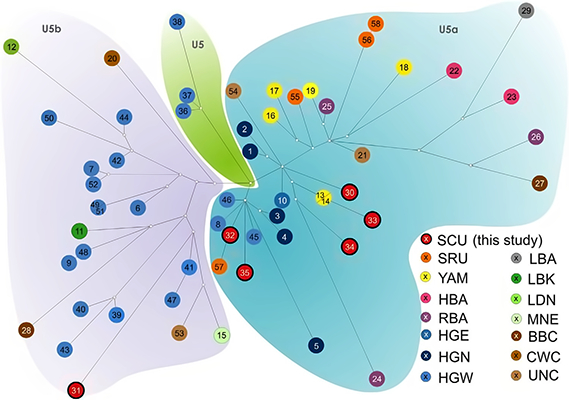
Median network of U5 haplotypes. Colours of nodes represent archaeological cultures where a particular haplotype was found. Numbers in nodes indicate particular haplotype (1–58) summarized in Supplementary Table S4. Population abbreviations: CWC, Corded Ware culture; BBC, Bell Beaker culture; HBA, Bronze Age populations from the geographic area of modern Hungary including Maros and Vatya individuals; HGE, Hunter-Gatherers from the East; HGN, Hunter-Gatherers from the North; HGW, Hunter-Gatherers from the West; LBK, Linear Pottery culture; LDN, Late Danubian cultures including a Rössen individual; MNE, Middle Neolithic cultures; NEN, Near Eastern Neolithic; RBA, Bronze Age populations from the geographic area of present-day Russia including Afanasievo and Karasuk individuals; SRU, Srubnaya culture; UNC, Unetice culture; YAM, Yamnaya culture; SCU, Scythians from Moldova and Ukraine from present study.
Photo and text: Juras et al. (2017)
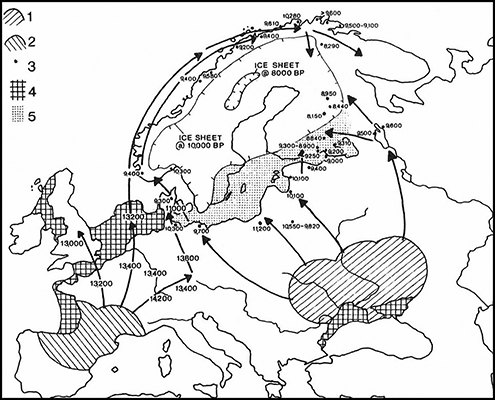
Routes taken for the reoccupation of land in Europe after the ice age.
1. Recolonisation of Eastern Europe.
2. Recolonisation of southwestern Europe.
3. Oldest regional settlement sites.
4. Shoreline towards the end of the ice age.
5. Yoldia Lake (before the breakthrough of the Baltic into the North Sea).
Photo: Haarmann (2016)
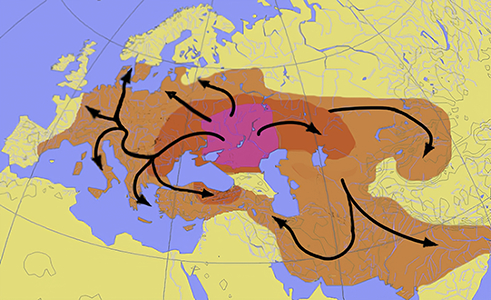
Indo-European expansion 4000–1000 BC, according to the Kurgan hypothesis.
Even within the Kurgan hypothesis, there is considerable uncertainty, mainly depending on assumptions about the w:Tocharians, the w:Corded ware culture and the w:Beaker culture.
The central purple area is supposed to show early w:Yamna culture (4 000 BC – 3 500 BC); the dark red area could show expansion to about 2500 BC, and the lighter red area expansion to about 1000 BC.
Photo: Dbachmann
Permission: Dbachmann, GNU Free Documentation License, Version 1.2 or any later version
Text: Wikipedia
Indo-European migrations
The Indo-European migrations were the migrations of the hypothetical Proto-Indo-European language (PIE) speakers, as proposed by contemporary scholarship, and the subsequent migrations of people speaking further developed Indo-European languages, which explains why the Indo-European languages are spoken in a large area from India and Iran to Europe.
Modern scholarly understanding of these migrations depends on a synthesis of data from linguistics, archaeology, anthropology and genetics. Comparative linguistics describes the similarities between various languages and the linguistic laws at play in the changes in those languages (see Indo-European studies). Archaeological data traces the spread of cultures presumed to be created by speakers of Proto-Indo-European in several stages: from the hypothesised locations of the Proto-Indo-European homeland, into their later locations Western Europe, Central, South and Eastern Asia by migrations and by language shift through élite-recruitment as described by anthropological research.[2][3] Recent genetic research has increasingly contributed to understanding of the relations between various prehistoric cultures.
According to the widely held Kurgan hypothesis, or the renewed Steppe hypothesis, the earliest proto-Indo-European speech community was identical with the archeological Yamnaya culture, and other related cultures in the Pontic–Caspian steppe, around 4000 BCE. Their descendants spread throughout Europe and parts of Asia, forming new cultures with the people they met on their way, including the Corded Ware culture in Northern Europe and the Vedic culture in the Indian subcontinent. These migrations ultimately seeded the cultures and languages of most of Europe, Greater Iran, and much of the Indian subcontinent (and subsequently resulted in the largest and most broadly-spoken language-family in the world).
Stages of culture and expansion
Overview of the Kurgan hypothesis
Gimbutas's original suggestion identifies four successive stages of the Kurgan culture:
Kurgan I, Dnipro/Volga region, earlier half of the 4th millennium BC. Apparently evolving from cultures of the Volga basin, subgroups include the Samara and Seroglazovo cultures.
Kurgan II–III, latter half of the 4th millennium BC. Includes the Sredny Stog culture and the Maykop culture of the northern Caucasus. Stone circles, anthropomorphic stone stelae of deities.
Kurgan IV or Pit Grave culture, first half of the 3rd millennium BC, encompassing the entire steppe region from the Urals to Romania.
Text above: Wikipedia

Aim and spheres of influence of the second migration wave (Kurgan II)
The end of the Atlantean period was marked by a drastic climate change, with exceptionally cold weather conditions in the period between 4 000 BC and 3 800 BC.
The ecological balance in the steppe was widely affected. This climate variability was probably responsible for the second migration movement (Kurgan Migration II), during which Proto Indo-Europeans penetrated far into the area of the farmers of the Trypillia culture.
During the Sub-boreal period (circa 3800-600 BC), the steppe belt dried out, resulting in a shortage of usable pastureland. The climate was generally dryer and slightly cooler (by about 0.1 °C) than in the preceding Atlantic but still warmer than today. The temperatures were 0.7 °C higher than during the following Subatlantic. Consequently, in Scandinavia the lower limit of glaciers was 100 to 200 m higher than during the Subatlantic.
Perhaps the third migration (Kurgan Migration III, circa 3 200 BC and 2 800 BC) was followed by ecological pressure to open up new pastureland in the West, which resulted in the decisive change of cultivated crops.
Photo and text: Haarmann (2016)
Additional text: Wikipedia
![]()
Kurgan nomads (in the Don-Volga lowland and north of the Black Sea).
![]()
Destination areas of migrating Kurgan nomads.
![]()
Border of the original Kurgan area.
![]()
Influence Corridors of the Second Kurgan Migration (Kurgan II).
Regional cultures that have been superimposed:
I. Cucuteni – Trypillia culture.
2. Funnel-neck beaker culture (TRB).
3. Michelsburg culture ( originally described from the site at Michelsberg, a hill near Untergrombach, between Karlsruhe and Heidelberg ).
Photo and text: Haarmann (2016)
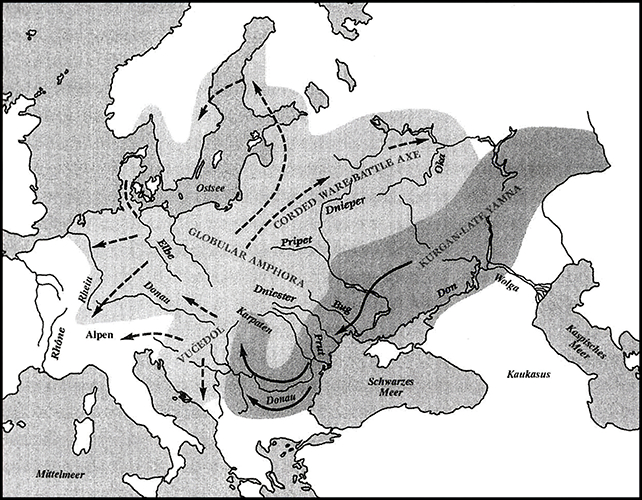
The third migration wave (Kurgan III) from the steppe.
Photo and text: Haarmann (2016)
![]()
The migration movements in the period between 3 200 - 2 800 BC.
![]()
Regional cultures before the third migration (Kurgan III).
Photo and text: Haarmann (2016)

Expansion of the Proto-Indo-European Yamna culture in the Early Bronze Age
Photo: https://www.eupedia.com/genetics/yamna_culture.shtml
The Scythians were nomadic and semi-nomadic people that ruled the Eurasian steppe during much of the first millennium BCE. While having been extensively studied by archaeology, very little is known about their genetic identity. To fill this gap, we analyzed ancient mitochondrial DNA (mtDNA) from Scythians of the North Pontic Region (NPR) and successfully retrieved 19 whole mtDNA genomes. We have identified three potential mtDNA lineage ancestries of the NPR Scythians tracing back to huntergatherer and nomadic populations of east and west Eurasia as well as the Neolithic farming expansion into Europe. One third of all mt lineages in our dataset belonged to subdivisions of mt haplogroup U5. A comparison of NPR Scythian mtDNA linages with other contemporaneous Scythian groups, the Saka and the Pazyryks, reveals a common mtDNA package comprised of haplogroups H/H5, U5a, A, D/D4, and F1/F2. Of these, west Eurasian lineages show a downward cline in the west-east direction while east Eurasian haplogroups display the opposite trajectory. An overall similarity in mtDNA lineages of the NPR Scythians was found with the late Bronze Age Srubnaya population of the Northern Black Sea region which supports the archaeological hypothesis suggesting Srubnaya people as ancestors of the NPR Scythians.Text above: Juras et al. (2017)
The Carpatho-Balkan metallurgical province area
Schematic map of the Carpatho-Balkan metallurgical province area.
A-Central bloc of settled farming cultures and communities. A-1-Butmir; A-2-Vinca C/D; A-3-Karanovo V-Maritsa; A-4-Karanovo VI-Gumelniöa; A-5-Varna; A-6-Lengyel; A-7-Tiszapolgar; A-8-Bodrogkresztur. B-Cultural block Cucuteni-Tripol'ye. C-block of the steppe stock-breeding cultures. C-1-Dnepro-Donets or Mariupol'; C-2-Sredni Stog; C-3-Khvalynsk
The beginning of the 'steppe belt' stockbreeding cultural formation is probably connected with the origin of the Carpatho-Balkan metallurgical province (CBMP) of the Copper Age and its swift explosive formation. In the period of maximal distribution and production of metal, the province’s territory was about 1.3 - 1.4 million km2. Within the array of mining and metallurgical centres composing the structure of the province, three basic groups of cultures can be reliably distinguished. The first and principal CBMP bloc consists of the mining and metallurgical centres localised in the northern Balkans and the Carpathian basin. Huge numbers of copper tools, weapons and ornaments were produced in these centres. The cultures of this bloc include such unique sites as the Varna gold necropolis and the Ai Bunar copper mine, the most ancient mine in the world known to date
that has been surveyed in detail. This bloc covers about 0.75 - 0.8 million km2.
Photo and text: Chernykh (2008)
Permission: CC BY-NC 4.0
The Pit-grave (Yamnaya) archaeological community (second phase of the CMP)
Schematic map of the Pit-grave (Yamnaya) archaeological community (second phase of the CMP) and its proposed
relation with Altay region (Afanasievo culture).
Distribution of variants of the Pit-grave community:
1 – Volga-Ural (in essence – Yamnaya culture); 2 – Volga-Ural (Poltavka culture); 3 – Kalmykia and Don-Donets basin; 4 – Dniepr and South Bug basins; 5 – N-W Black Sea area.
The Yamnaya culture, , also known as the Pit Grave culture, or Ochre Grave culture, was a late Copper Age to early Bronze Age archaeological culture of the region between the Southern Bug, Dniester, and Ural rivers (the Pontic steppe), dating to 3 300 - 2 600 BC. Its name derives from its characteristic burial tradition: kurgans containing a simple pit chamber.
The people of the Yamnaya culture were likely the result of admixture between the descendants of Eastern European hunter-gatherers[a] and people related to hunter-gatherers from the Caucasus. Their material culture was very similar to the Afanasievo culture.
The genetic basis of a number of physical features of the Yamnaya people were ascertained by the ancient DNA studies: they were genetically tall (phenotypic height is determined by both genetics and environmental factors), overwhelmingly dark-eyed (brown), dark-haired and had a skin colour that was moderately light, though somewhat darker than that of the average modern European. Despite their pastoral lifestyle, there was little evidence of lactase persistence, that is, the ability of adults to digest dairy products.
Photo and text: Chernykh (2008)
Permission: CC BY-NC 4.0
Additional text: Wikipedia
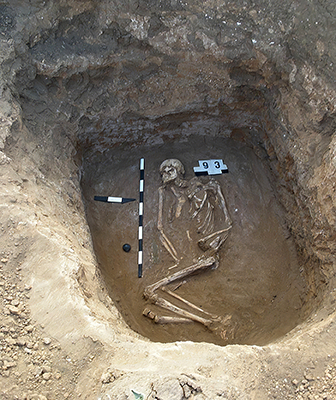
Yamna culture tomb in Volgograd oblast.
Photo and text: XVodolazx
Permission: Creative Commons Attribution-Share Alike 3.0 Unported license
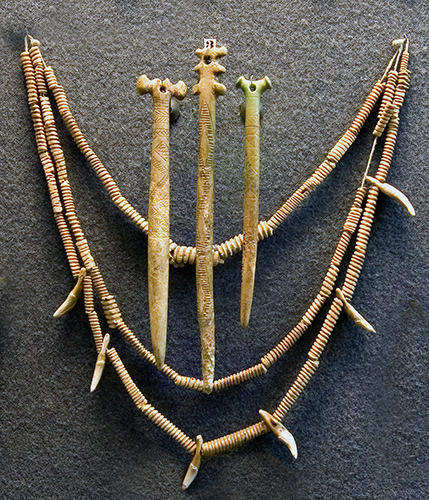
Ornaments and items of adornment in bone and canine teeth from the collection of the Hermitage Museum in St. Petersburg in Russia.
Late copper age (Yamna culture)
Photo and text: EvgenyGenkin
Permission: Creative Commons CC BY 2.5
Source: Hermitage Museum, St Petersburg, Russia.
The Catacomb Community
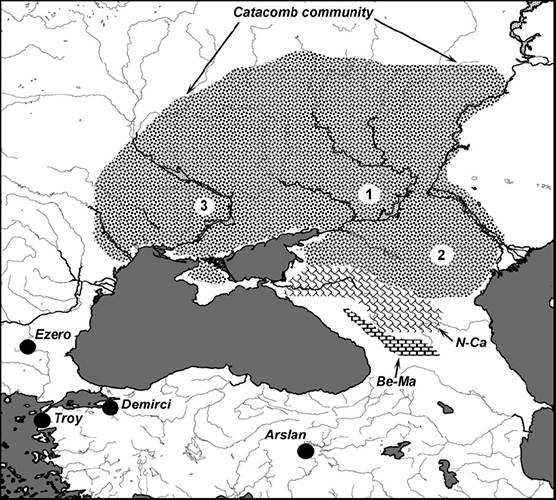
Schematic map of the Catacomb archaeological community and others cultures (late phase of the CMP).
Catacomb community:
1 - Don/Donets basin; 2 - Kalmykia; 3 - Dniepr and South Bug basins. N-Ca - North- Caucasian archaeological community. Be-Ma - Bedeni - Martkopi kurgan culture.
The name Catacomb culture comes from its burial practices. These are similar to those of the Yamnaya culture, but with a hollowed-out space off the main shaft, creating the 'catacomb'. Animal remains were incorporated into a small minority of graves.
In certain graves there was the distinctive practice of what amounts to modelling a clay mask over the deceased's face.
The economy was essentially stock-breeding, although traces of grain have been found. There seem to have been skilled specialists, particularly metal-workers.
The origin of the Catacomb culture is disputed. Lichardus (1987) gives three possibilities: a local development departing from the previous Yamnaya Culture only, a migration from Central Europe, or an oriental origin. The culture is the first to introduce corded pottery decorations into the steppes and shows a profuse use of the polished battle axe, providing a link to the West. Parallels with the Afanasevo culture, including provoked cranial deformations, provide a link to the East.
Excavations in 2012 of 26 mounds near Storozhove village in Chutove Region of Poltava Oblast revealed three layers of Catacomb culture archaeology. The earliest were the burials of the 'Donetsk' phase of Catacomb culture (also known as Dnipro–Donets culture); the dates were 3 050 - 2 190 cal BC. Then came the burials of 'Inhul' phase (named after the Inhul river). Later material belonged to the Berezhnivsko-Maivska type of Srubna culture (Timber-grave culture) (1 880 - 1 530 cal BC).
The Catacomb culture was replaced by the Srubna culture from c. 17th century BC.
Photo and text: Chernykh (2008)
Permission: CC BY-NC 4.0
Additional text: Wikipedia, Lichardus (1987)
The Yamnaya and Catacomb communities: the problem of chronological correlations
It should be noted that Chernykh (2008) posits that, in a rather extensive territory of southeastern Europe, an area of no less than 0.7 million km2, two huge archaeological communities – Yamnaya and Catacomb – coexisted approximately during six hundred years.
Excavations at Dubrava, Дубрава, 2013, of a site dated to 1750 BC.
These excavations were undertaken under the supervision of the distinguished archaeologist, Valery Berezutsky, from the Voronezh State Pedagogical University
The Srubnaya culture (Log house culture, Timber-grave culture), was a Late Bronze Age (18th–12th centuries BC) culture in the eastern part of Pontic-Caspian steppe. It is a successor to the Late Catacomb culture and the Poltavka culture, as well as the Potapovka culture.
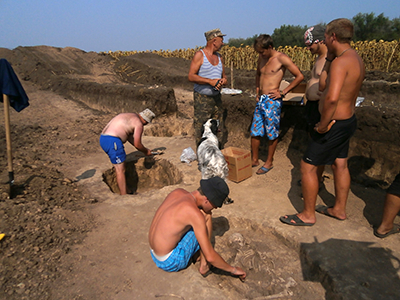
The site, set amongst agricultural fields and a nearby forest, dates to 1750 BC.
Photo: Vladimir Gorodnjanski, 2013
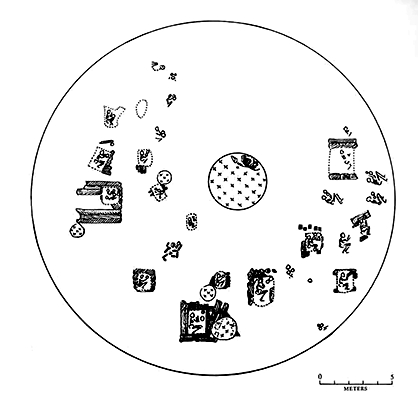
Plan of barrow No. 5 at Yagodnoe, district of Kuibyshev. In the middle is a fireplace with the skeleton of a cow or bull. Late Classical phase.
Photo and text: Gimbutas (1961)
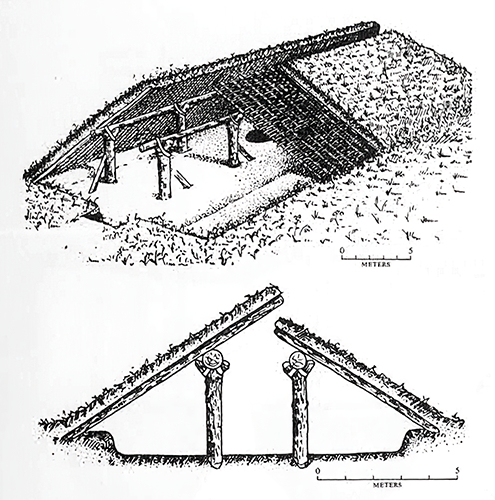
Settlements of the Timber-grave Culture are found on the terraces of both large and small rivers. At one site only about ten houses were found, and the settlement pattern was irregular. The number of families living in one village probably did not exceed twenty, comprising perhaps one to two hundred people. The houses were semi-subterranean and rectangular in plan. They ranged in size from fifteen to twenty-five feet in length in the Early and Classical periods, to sixty-five feet and more in length during the Late period.
This reconstruction of a Late Timber-grave semi-subterranean house is based on one found at the Pervoe Suskan ste, district of Kuibyshev.
( Note the clever construction. The roof is of steeply sloping sod/grass supported by a strong wickerwork foundation, resting on two lines of posts and rails. The perennial problem of ridge capping with such a gabled roof design is solved elegantly by having one of the roofs higher than the other, and overlapping it to provide weather protection. It would presumably have to have been sited with the higher roof towards the (northerly?) prevailing winds, and overlapping more than is shown in the diagram if rain and snow were to be completely excluded. The gap provides ventilation and a place for the egress of woodsmoke, but if I were constructing it I would keep this gap to a bare minimum. There is such a thing as too much ventilation, especially on the steppes! - Don
Photo and text: Gimbutas (1961)
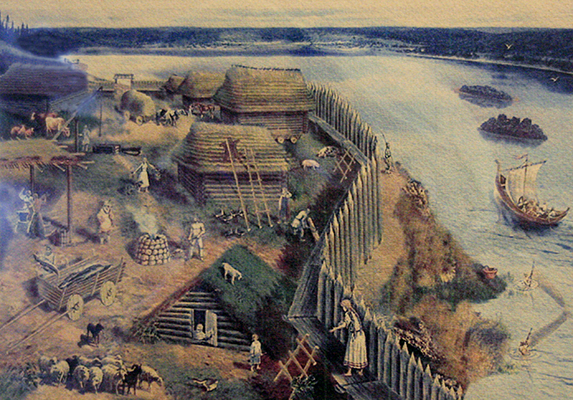
A recreation of what is labelled as a 'Slavic Village' in a display from the Ostrogozhsk Regional Museum of Local Lore, Voronezh Region.
This painting incorporates many different cultures into the one painting, but is valuable nevertheless.
In the foreground is a classic house of the Timber-grave culture, on the terrace of a large river. There are about six to ten houses altogether in this settlement, and the house in the foreground is both semi-subterranean and of rectangular design, with a sod roof and a log end wall.
The other buildings appear to be from a later period, and are of classic log-cabin wholly above ground construction, with what appears to be rush or straw roofs. There are domesticated cattle, sheep, horses, geese, and pigs in the village bounds, which are protected by a palisade with sharpened stakes, indicating that protection against raiders was necessary. To this end, there is a wooden walkway half way up the palisade, from which defenders could drop rocks or, more likely, use spears tipped with sharp bronze (or iron) points to repel invaders.
Within the village precincts there is a kiln for either ceramics or bronze, or for heating iron - there is an anvil under a flat roof, with two men stripped to the waist forging a tool or weapon with heavy hammers.
In addition, there are wheeled vehicles designed to be pulled by horses or oxen, and what may be a shaduf, an ancient hand operated device for lifting water from a well using a long pole and a counter weight.
Artist: Unknown
Rephotography: Vladimir Gorodnjanski, 2015
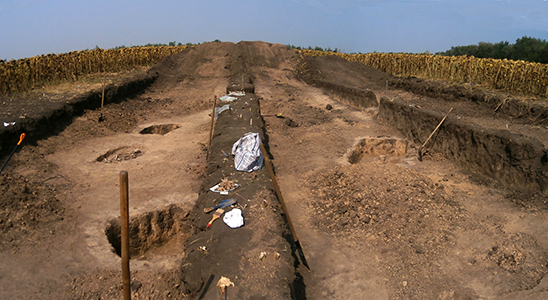
The site was prepared by using earthmoving equipment to remove the overburden.
Photo: Vladimir Gorodnjanski, 2013
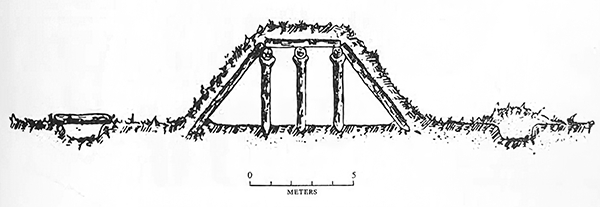
A cross-section of a reconstructed timber house-grave from the cemetery of Kaibely, district of Ulianovsk, middle Volga area.
Photo and text: Gimbutas (1961)

This burial site shows a skeleton in a flexed, foetal position, with a few simple ceramic gravegoods.
Photo: Vladimir Gorodnjanski, 2013
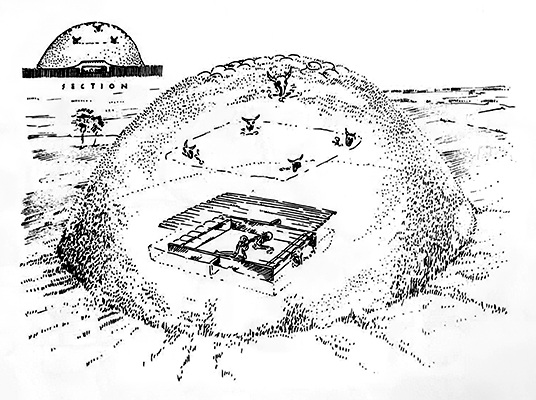
Section and plan of the barrow from the cemetery of Kamyshevkha near Bakhmut, lower Donets basin.
Fireplaces with bones of sacrificed cattle are above the human grave.
Photo and text: Gimbutas (1961)
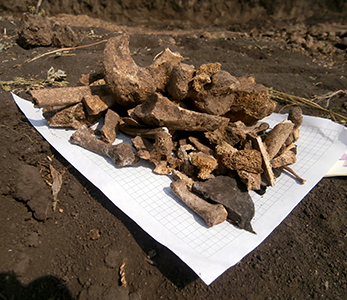
As well as human bones and ceramic pots, there are, in this culture, always animal bones from the sacrifices in the kurgans, as here.
Photo: Vladimir Gorodnjanski, 2013
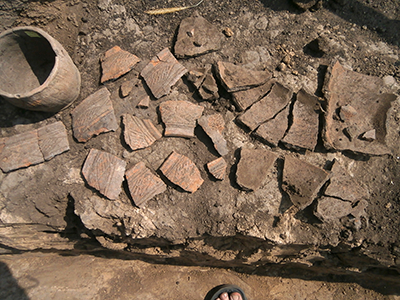
There are two distinct styles of pots here.
The undamaged pot on the left is a utilitarian, undecorated piece. Beside it are several shards from one or more pots which are decorated with dots and lines.
Photo: Vladimir Gorodnjanski, 2013
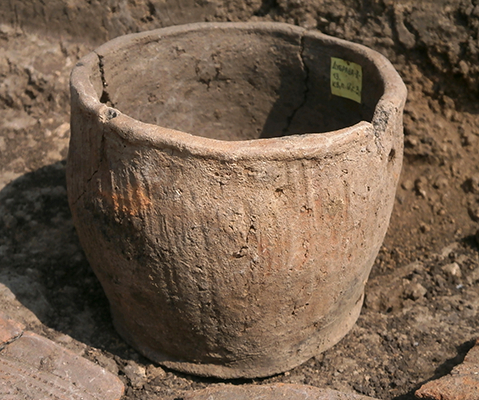
The utilitarian pot shown above and to the left, here, has been given a thick lip, to protect it from breakage.
Photo: Vladimir Gorodnjanski, 2013

Broken decorated pot. Note the firing colours from both sides to the centre of the shards.
The pot has had different oxidation conditions on the inside of the pot than on the outside, turning that part a darker shade. It was probably fired in a pit, filled and covered with wood fuel, rather than in a kiln.
If the wood around the pots is set alight, and then when burning well, covered with more earth, relatively even temperatures may be achieved, even with this method, and there will be few breakages from uneven temperatures.
Photo: Vladimir Gorodnjanski, 2013
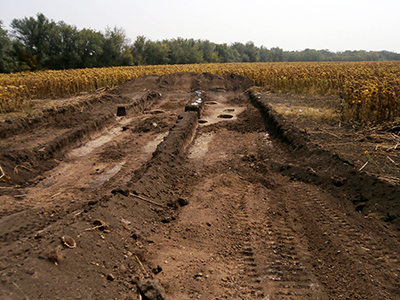
The site was in a sunflower field. It requires a great deal of experience and knowledge to determine where it is worthwhile to send in the earthmoving equipment.
Photo: Vladimir Gorodnjanski, 2013
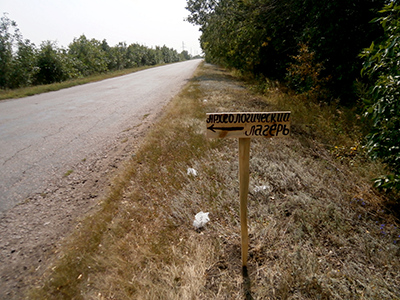
Each year the actual dig site is determined anew. A small hand painted sign is used to direct the students and volunteers to the site to work during the summer campaign.
Photo: Vladimir Gorodnjanski, 2013
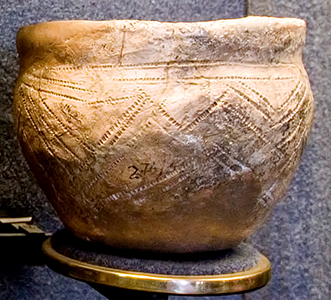
Srubna Culture pot.
Photo and text: EvgenyGenkin
Permission: Multi-license with GFDL and Creative Commons CC-BY 2.5
Source: Hermitage Museum, St Petersburg, Russia.
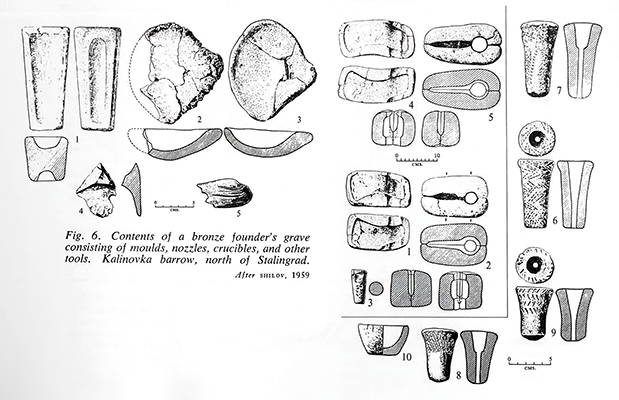
Contents of a bronze founder's grave consisting of moulds, nozzles, crucibles, and other tools.
Kalinovka barrow, north of Stalingrad.
Photo and text: Gimbutas (1961)
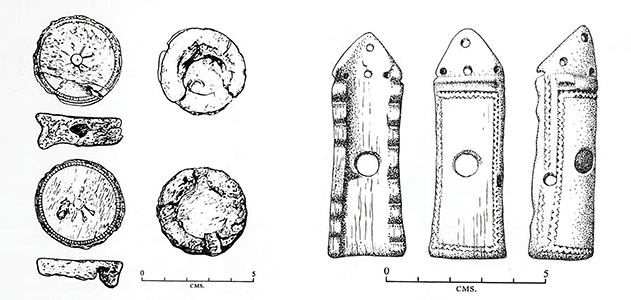
Srubna Culture
(left) Ornament plates of bone used for horses’ bridle. Cemetery Ilovatka near Stalingrad.
(right) Cheek-piece of bridle made of bone. Komarovka cemetery, district of Kuibyshev.
Photo and text: Gimbutas (1961)
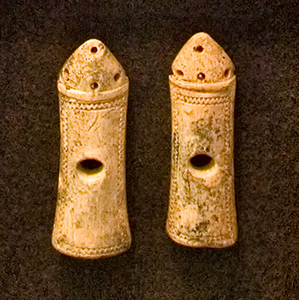
Cheek-pieces of bridle made of bone.
Komarovka cemetery, district of Kuibyshev, as above, right.
Photo: EvgenyGenkin
Permission: Multi-license with GFDL and Creative Commons CC-BY 2.5
Text: Gimbutas (1961)
Source: Hermitage Museum, St Petersburg, Russia.
Archaeologists find 3 400 year old burial of children in Voronezh Region
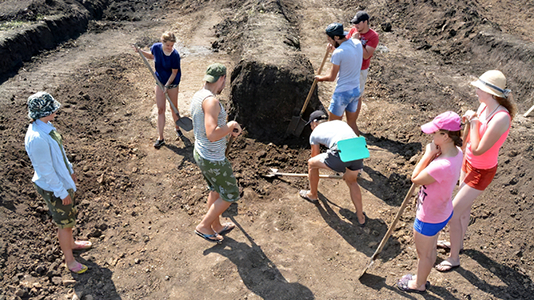
Students of the Faculty of Humanities of the Voronezh State Pedagogical University under the guidance of teacher and archaeologist Valery Berezutsky found four children’s graves in a field near the village of Dubrava, Дубрава, of Boguchar District on Thursday, 4th August 2017. The archaeologists believe that the children were sacrificed in the XV-XIV century BC. The remains will be taken to the vault of the Archaeological Museum of the Pedagogical University.
Photo and text: Natalia Lifintseva
Source: https://en.riavrn.ru/news/v-voronezhskoy-oblasti-arkheologi-nashli-zakhoroneniya-detey-3400-letney-davnosti/
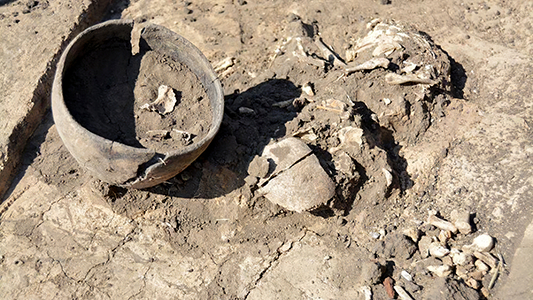
Presumably, the boys and the girls were sacrificed to another person buried.
The burials date back to the Timber-grave culture. According to Valery Berezutsky, children up to 12 years old were sacrificed to a buried person to release his or her soul burdened by sins.
Reaching the age of 12 years, boys and girls were considered adults, and they were dedicated to their adult life, Berezutsky explained. - Families sacrificed their children voluntary. It was believed that it was a blessing, and the child immediately got in a wonderful place. Such rites were performed by the tribes of the Timber-grave culture. They were borrowed from the Aryans who had their religion and ideology.
Photo and text: Natalia Lifintseva
Source: https://en.riavrn.ru/news/v-voronezhskoy-oblasti-arkheologi-nashli-zakhoroneniya-detey-3400-letney-davnosti/
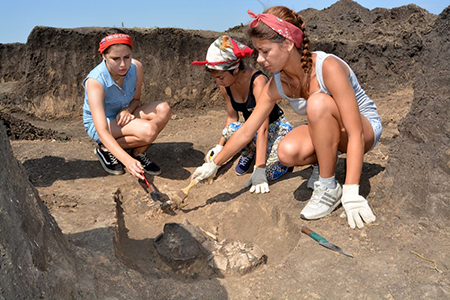
It is almost impossible to determine whether the children were killed simultaneously or at different times. The archaeologists have not yet found the burial of the tribe's chief man, around whom the children's graves were found. The students have found only four children's graves, but the archaeologists have suggested that there may be more of them.
The Voronezh Pedagogical University students have been visiting the Medovskoe settlement of Boguchar District for archaeological workshops for 17 years. The excavations are also voluntarily joined by pupils from Pavlovsky District and Boguchar who attend the archaeological camp 'Back to Basics', headed by the commander of the local search group 'Pamyat' ('Memory'), Nikolai Novikov.
Photo and text: Natalia Lifintseva
Source: https://en.riavrn.ru/news/v-voronezhskoy-oblasti-arkheologi-nashli-zakhoroneniya-detey-3400-letney-davnosti/
Burials were examined from the mounds at the villages of Arkhipovka, Loshina and Golubaja Krinica
Much of the following is from Berezutsky and Grinev (2008) except where otherwise indicated
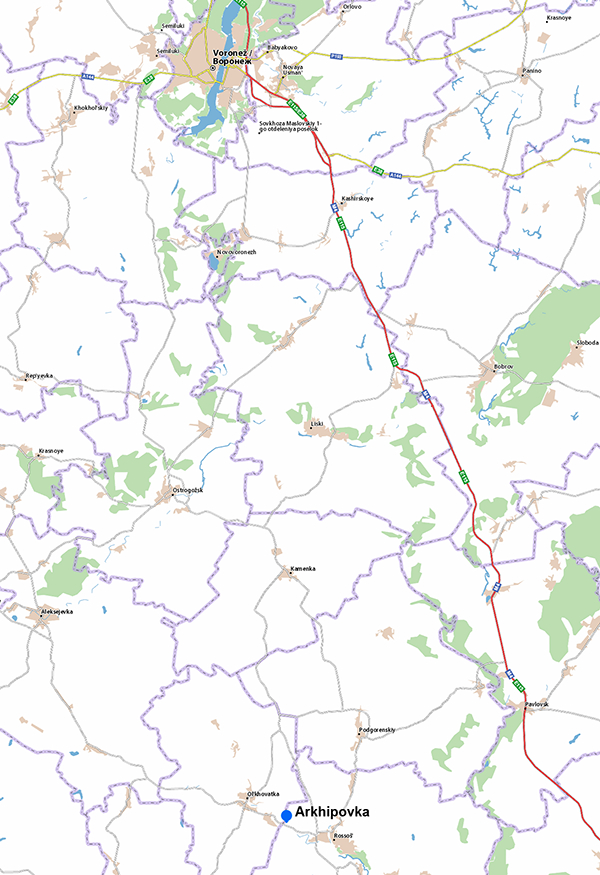
left: Location of Arkhipovka with respect to Rossosh and Voronezh.
The Arkhipovka burial mounds consist of eight prominent knolls located on the low right bank of the Chernaja Kalitva River, at a height above the floodplain of 6-8 metres, on the western outskirts of Arhipovka. However, this number corresponds only to current observations, and it seems likely that there will be at least two more burial mounds in the local area.
Arkhipovka is a village of 1336 people, at 50° 12′ 50" N, 39° 24′ 45" E, and is 8 km west of Rossosh at an altitude of 80 m above sea level.
Photo: Michelin Maps
Text: Berezutsky and Grinev (2008)
Location of Golubaja Krinica, or Blue Well, Голубая Криница, as well as Loshina, Лощина, and their location with respect to Rossosh, Россошь.
Golubaja Krinica - the farm/small village of 138 people is located in the southern part of the Voronezh region, in the steppe zone, south of the Chernaya Kalitva river , at a distance of about 15 kilometres to the east-south-east from the city of Rossosh , the district administrative centre. The altitude is 84 metres above sea level, at 50°04′26" N, 39°53′42″ E.
Loshina - The farm/small village is located in the southern part of the Voronezh region, in the steppe zone, west of the Don River , west of the Black Kalitva River , at a distance of about 12 kilometres east of the city of Rossosh , the district’s administrative centre. The altitude is 78 meters above sea level, at 50°08′08″N, 39°53′40″E
Photo and text: Wikipedia
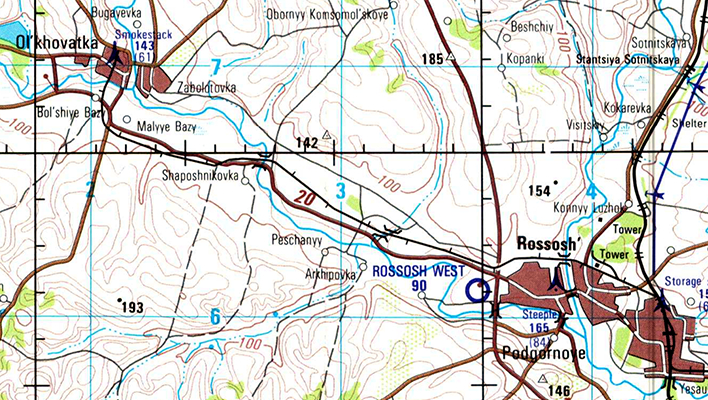
Location of Arkhipovka, between Rossosh and Ol'khovatka.
Photo: http://legacy.lib.utexas.edu/maps/jog/russia/nm-37-5-rossosh-ussr.pdf
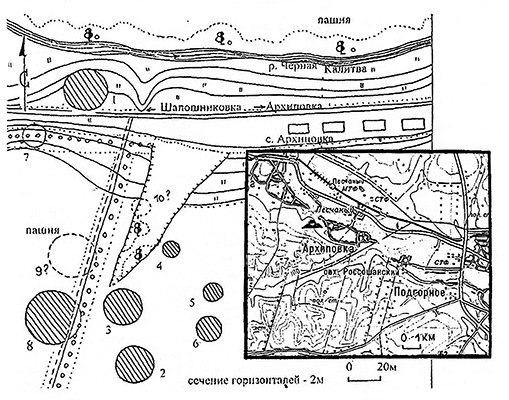
Plan of the mound burials at Arkhipovka.
Photo and text: Berezutsky and Grinev (2008)
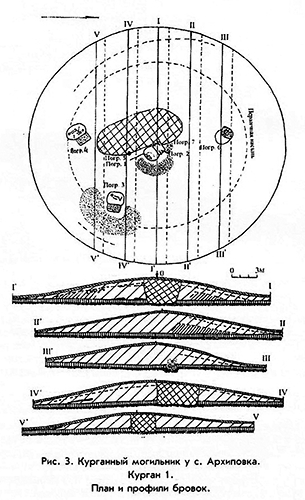
Fig 3.
Kurgan number 1 at Arkhipovka, showing the plan and profiles.
This was located in the northern part of the grave near the small river bank and it was significant in height — up to 2.5 m from the modern surface. The diameter was up to 30 m, the shape of the mound was that of a spherical cap or dome. The stratigraphy of the layers during the excavations revealed the following:
The mound consisted of an homogeneous chernozem, lying under a 0.2m thick cairn.
Under the zero mark chosen at the top of the kurgan, the mound thickness was 2.6 m. The buried soil, up to 0.5 m thick was distinguished by a darker colour than the mound and was underlain by yellow clay.
Photo and text: Berezutsky and Grinev (2008)
In the course of excavations in the central part of the mound, traces of grave robbing, including a shaft of oval/crescent shape up to 5 m wide and 10 m long were found. Perhaps the mound was robbed several times, as a result of which the entry shaft took such a shape. Older residents of Arkhipovka remembered that this mound was once robbed by a local resident.
The shaft reached ground level and destroyed at least two burials. During excavations in the shaft, the bones of a man, a horse, and also some grave goods were found. In total, seven burials were found in the mound.
Burial 1 (Srubnaya culture, log cabin culture) was located in the centre of the mound at a depth of 90 cm from the zero mark in the embankment above the chamber of the main burial in chamber 2. In it were the poorly preserved remains of a child.
( note that the Srubnaya people have been identified as the ancestors of the Scythians - Don )
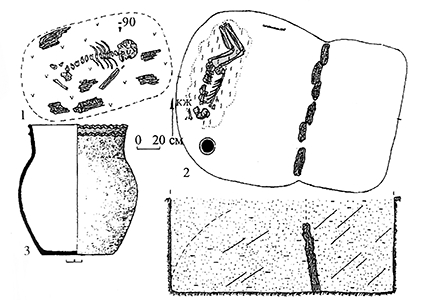
Рис. 4.
курганный могилник у с. Архиnовка.
курган 1.
1 - погребение 1.
2, 3 - погребение 3.
Kurgan grave in Arkhipovka.
Kurgan 1.
1 - burial 1.
2, 3 - burial 3
Photo and text: Berezutsky and Grinev (2008)
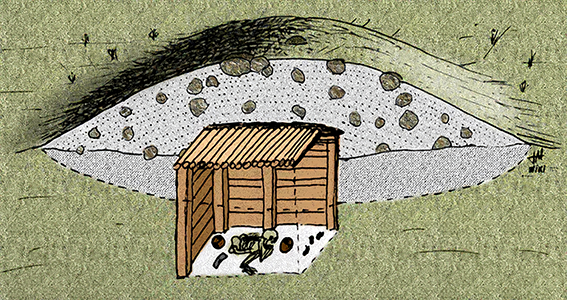
The Bronze Age Srubna Culture and their Unique Timber Graves for the Dead
Not much is known about the ancient Srubna (or Srubnaya) peoples of Eastern Europe as writing and records were either not developed, or the materials they were written on have not survived. As a result, we are reliant on the archaeological records to provide us with information about these interesting people who created timber kurgan graves and wooden framed dwellings that were said to remain standing generation after generation.
The Srubna (meaning 'timber grave' in Russian) people were located in the steppe and forest-steppe region to the north of the Black Sea and Caspian Sea. This culture existed during the Late Bronze Age, between 1700 and 1200 B.C. The name of this Bronze Age culture is derived from the way their burial structures were normally constructed —using timber frameworks. Some of these structures, however, have slabs of stones, instead of wood, for their walls.
Photo and text: https://www.ancient-origins.net/history/bronze-age-srubna-culture-and-their-unique-timber-graves-dead-002897
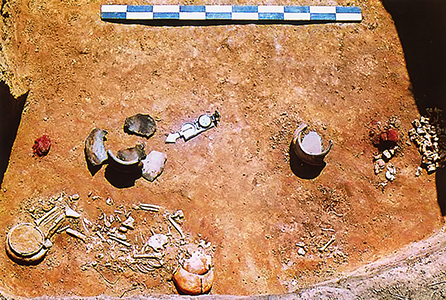
Рис. 66
Курганный могилник у с. Архиповка. Курган 8.
поrребение 3
Arkhipovka Kurgan 8.
Burial 3.
Photo and text: Berezutsky and Grinev (2008)
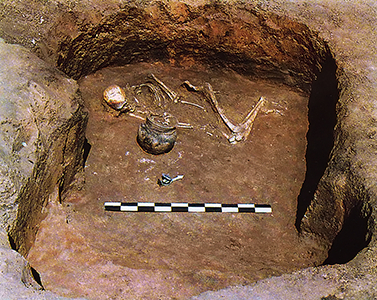
Рис. 66
Курганный могилник у с. Архиповка. Курган 8.
погребение 2.
Arkhipovka Kurgan 8
Burial 2.
Photo and text: Berezutsky and Grinev (2008)
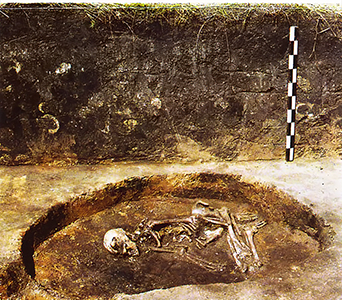
Рис. 67
курган у хут. Лощина, погребение 13.
The burial in the hut. Pit, burial 13.
Photo and text: Berezutsky and Grinev (2008)
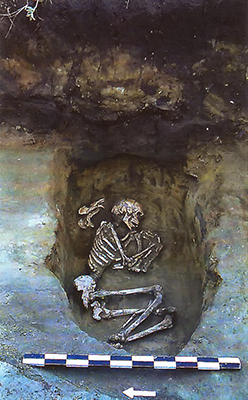
Рис. 67
курганный могильник у хут. Голубая Криница , курган l, погребение 3.
Burial. Kurgan 1, burial 3.
Photo and text: Berezutsky and Grinev (2008)
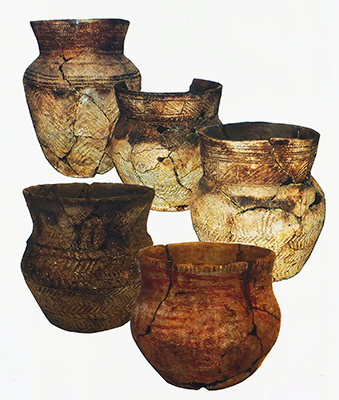
Рис. 68. Курганный могильник у с. Архиповка.
Сосуды из пorpeбeний среднедонской катакомбной кудьтуры (масштаб разный).
Burial from the Arkhipovka kurgans.
Vessels from burials of the Middle Don Catacomb Culture (various scales).
The Catacomb culture (2800 - 2200 BC) is a group of related cultures in the early Bronze Age occupying essentially what is present-day eastern Ukraine and southern Russia.
The culture applied cord-imprinted decorations to its pottery and had a profuse use of the polished battle axe.
Photo and text: Berezutsky and Grinev (2008)
Additional text: Wikipedia
The Catacomb CultureText above: Harding & Fokkens (1961)
Around the middle of the third millennium BC at the latest, the Yamnaya culture was replaced right across the North Pontic steppe area by the Katakombna (Catacomb Grave) culture, which was dispersed in roughly the same region. Radiocarbon dating puts the Catacomb culture in the period between 2500 and 1950 BC. It thus coincides exactly with the older phase of the Early Bronze Age in central Europe. It is assumed though that the eastern Catacomb burials in the area between the Don, Volga, and Caucasus foothills appeared even earlier and went back to the late Yamnaya culture there. Regional groups can be distinguished within the Catacomb culture, as in the Yamnaya period. Common to all the groups are the so-called catacomb grave complexes-kurgans with an entrance shaft and burial niches in its side walls. The dead were buried in both crouched and supine positions. Graves that contained wagons with two, or even four, disc wheels represented members of an elevated social stratum, as in the Yamnaya and Novotitarovka periods. Smiths' graves appear, with casting moulds, crucibles, and clay nozzles. Otherwise, graves and grave gifts are largely similar across the Catacomb territory, and only occasionally do individuals stand out.
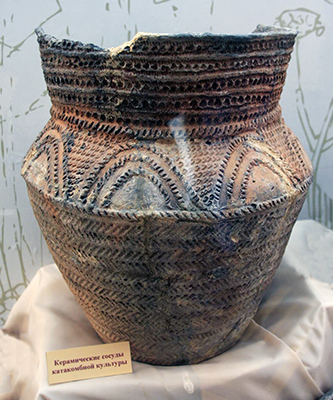
керамические сосуды катакомбной культуры
Ceramic vessel of the Catacomb Culture.
Photo: Vladimir Gorodnjanski, 2015
Source and text: Ostrogozhsk Regional Museum of Local Lore, Voronezh Region.
Photo: Haarmann (2016)

Model of a wagon with solid wheels from the Eurasian steppe (4th and 3rd millennium BC).
Photo and text: Photo: Haarmann (2016)
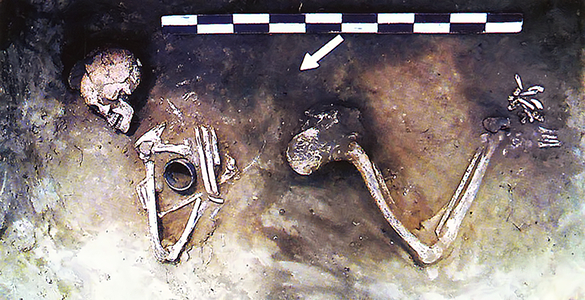
Рис. 69. курган у хут. Голубая Криница, погребение.
Burial mound at Golubaja Krinica, a burial.
Photo and text: Berezutsky and Grinev (2008)
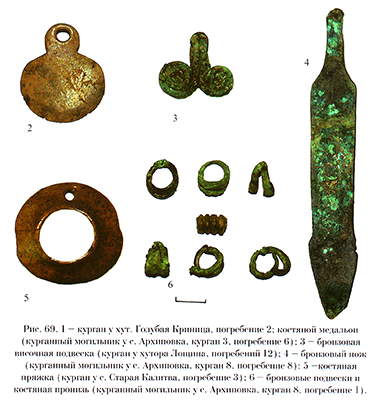
2 - костяной медальон (курганный могильник у с. Архиnовка , курган 3, погребение 6).
3 - бронзовая височная nодвеска (курган у хутора Лощина, погребений 12).
4 - бронзовый нож (курганный могил ьник у с. Архиnовка, курган 8 , погребе ни е 8).
5 - костяная nряжка (курган у с . Старая Калитва , погребение 3).
6 - бронзовые подвески и костяная пронизь (курганный могилник у с. Архиnовка , курган 8, погребе ние l).
2 - bone medallion from the burial mound in Arkhipovka, kurgan 3, burial 6.
3 - bronze non-spiritual pendant from the mound at the Loshina farm, 12 burials.
4 - bronze knife (barrow grave near the village of Archinovka, barrow 8, cellar below 8)
5 - bone harness (mound near the village of Staraya Kalitva, burial 3).
6 - bronze pendants and bone penetration (barrow grave near the village of Archinovka, barrow 8, burial l).
Photo and text: Berezutsky and Grinev (2008)
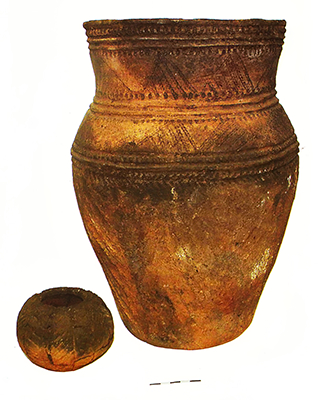
Рис. 70. Сосуд среднедонской катакомбной культуры (справа) и сосуд манычской культуры ( слева) . Курганный моrильник у с. Архиповка, курган 1, поrребение 2.
Kurgan burial at Arkhipovka, kurgan 1, burial 2.
Vessels of Manych Culture (left) and the Middle Don Catacomb Culture (right).
Photo and text: Berezutsky and Grinev (2008)
The Catacomb CultureText above: Anthony (2019)
The earliest graves assigned to the Catacomb culture date to perhaps 2 800 - 2 700 BC and are located in the steppes north of the northern Caucasus, among societies of the Novotitorovskaya type that were in close contact with late Maikop culture, and in the Don Valley to the north. Along the Volga, graves containing Poltavka pottery appeared by 2 800 - 2 700 BC as well; Poltavka was very much like the earlier eastern Pit Grave culture, but with larger, more elaborately decorated, flat-based pots. By about 2 600 - 2 500 BC Catacomb traditions spread westward over the entire North Pontic region as far as the mouth of the Danube. Poltavka persisted through the Middle Bronze Age in the Volga-Ural region.
The Catacomb culture made sophisticated arsenical bronze weapons, tools, and ornaments, probably using Caucasian alloying recipes. Northward, on the Volga, the Poltavka culture continued to use its local 'pure' copper sources, rather than the arsenical bronzes of the south. T-shaped pins of bone and copper, perhaps hairpins, were a common late Pit Grave-Catacomb type. Many metal shaft-hole axes and daggers were deposited in graves. The same kinds of ornate bronze pins and medallions are evident in the Middle Bronze Age royal kurgans of the northern Caucasus (Sachkere, Bedeni, and Tsnori) and the settlements of the Caspian Gate (Velikent) on the one hand and the Middle Bronze Age sites of the steppes on the other. These finds imply an active north-south system of Middle Bronze Age trade and intercommunication between the steppes and the Caucasus. Evgeni N. Chernykh, a specialist in metals and metallurgy, has speculated that up to half of the output of the Caucasian copper industry might have been consumed in the steppes to the north. Wagon burials continued in the Catacomb region for exceptional people. In the Ingul valley, west of the Dnipro, as well as in the steppes north of the Caucasus, some Catacomb graves contained skeletons with clay death masks applied to the skull.
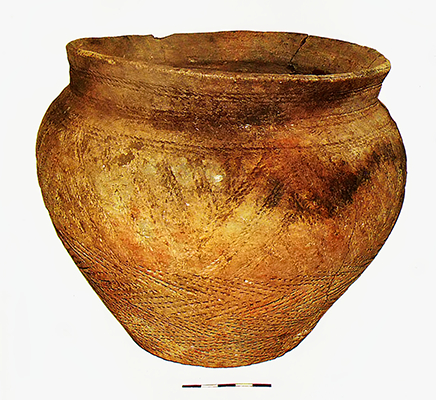
Рис. 71. Cocyд иэ погребения среднедонской катакомбной куrьтуры. Курган у xyт.
Лощина, погребение 20.
Vessel from a burial of the Middle-Don catacomb culture. Kurgan at the hut.
Pit, burial 20.
Photo and text: Berezutsky and Grinev (2008)
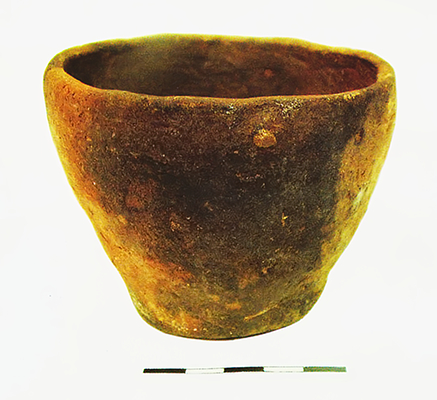
Рис . 72. Сосуды срубной культуры . Курганный моrильник у хут .
Голубая Криница, курган l , погребение 4.
Srubnaya (log cabin) culture vessel. Kurgan burial site at hut.
Blue Krinitsa, Kurgan l, burial 4.
Photo and text: Berezutsky and Grinev (2008)

Рис . 72. Сосуды срубной культуры . Курганный моrильник у хут .
Голубая Криница, курган l , погребение 4.
Srubnaya (log cabin) culture vessel. Kurgan burial site at hut.
Blue Krinitsa, Kurgan l, burial 4.
Photo and text: Berezutsky and Grinev (2008)
srubnayagravedrawing_2gsm 567 300
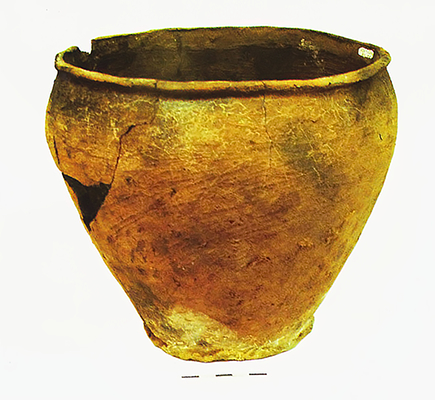
Рис . 72. Сосуды срубной культуры . Курганный моrильник у хут.
Голубая Криница, курган l, погребение 1.
Srubnaya (log cabin) culture vessel. Kurgan burial site at hut.
Blue Krinitsa, Kurgan l, burial 1
Photo and text: Berezutsky and Grinev (2008)
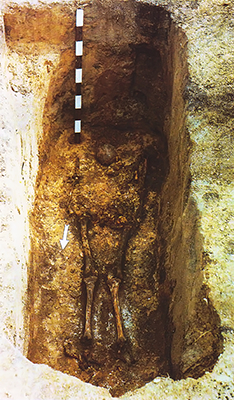
Рис. 73. Курганный моrильник у с . Архиповка.
Курган 6. Сарматское погребение .
Kurgan burial at Arkhipovka.
Kurgan 6. Sarmatian burial.
Photo and text: Berezutsky and Grinev (2008)
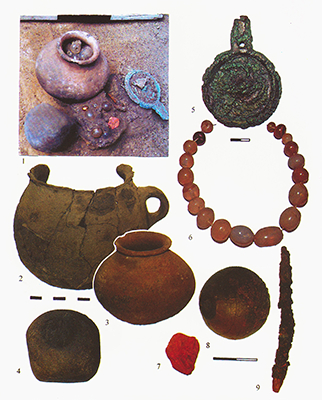
Рис. 75. Курганный моrильник у хут. Голубая Криница.
Курган 3, поrребение 1.
1 - расположение погребального инвентаря в могиле.
2 - сероглиняная кружка.
3 - гончарный сосуд.
4 - растиралыник.
5 - зеркало.
6 - ожерепье из бус.
7 - охра.
8 - пряслице.
9 - шило
(2, 3, 8 - глина, 4 камень , 5- бронза , 6- стекло,
сердолиnк, сардер , халцедон , 9 - железо).
Kurgan burial in the hut. Krinitsa.
Kurgan 3, grave 1.
1 - the location of the grave goods in the grave.
2 - grey clay mug.
3 - pottery vessel.
4 - mortar.
5 - a mirror.
6 - bead necklace.
7 - ochre.
8 - spindle whorl.
9 - awl.
(2, 3, 8 - clay, 4 stone, 5 - bronze, 6 - glass,
carnelian, sarder, chalcedony, 9 - iron).
( sarder is a variety of brown chalcedony with a reddish tinge - Don )
Photo and text: Berezutsky and Grinev (2008)
Additional text: Wikipedia

Рис. 76. Курганный могильник у с. Архиповка.
Сосуды из погребений сарматской культуры (масштаб разный).
Kurgan burial ground, Arkhipovka.
Vessels from burials of the Sarmatian culture (at different scales).
Photo and text: Berezutsky and Grinev (2008)
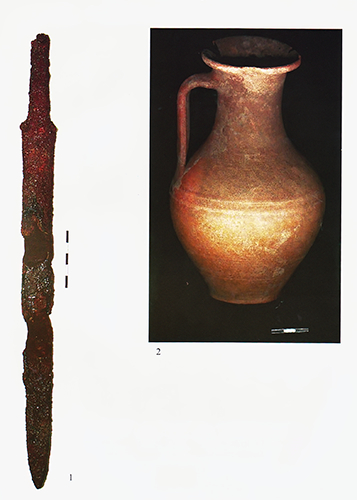
Рис. 77.
1 - железный сарматский меч
(курганный моrильник у с. Архиповка , курган 4);
2 - гончарный кувшин из сарматского погребения
(курганный могильнк у с. Архиповка, курган 3, погребение 4)
1 - Iron Sarmatian sword
(kurgan burial ground, near the village of Archipovka, kurgan 4)
2 - pottery jug from a Sarmatian burial
(kurgan burial ground near the village of Arkhipovka, kurgan 3, burial 4)
Photo and text: Berezutsky and Grinev (2008)

Рис. 79.
Курган у хут. Лощина. Средневековое погребение 21.
1- детали головного убора; 2- подвески; 3- амулет
( 1 - медь, 2 - бронза, 3 - стекло)
Fig. 79. Kurgan at the village of Лощина, Loshina. Medieval, burial 21.
1- details of a headdress; 2- pendant; 3- amulet
(1 - copper, 2 - bronze, 3 - glass)
Photo and text: Berezutsky and Grinev (2008)
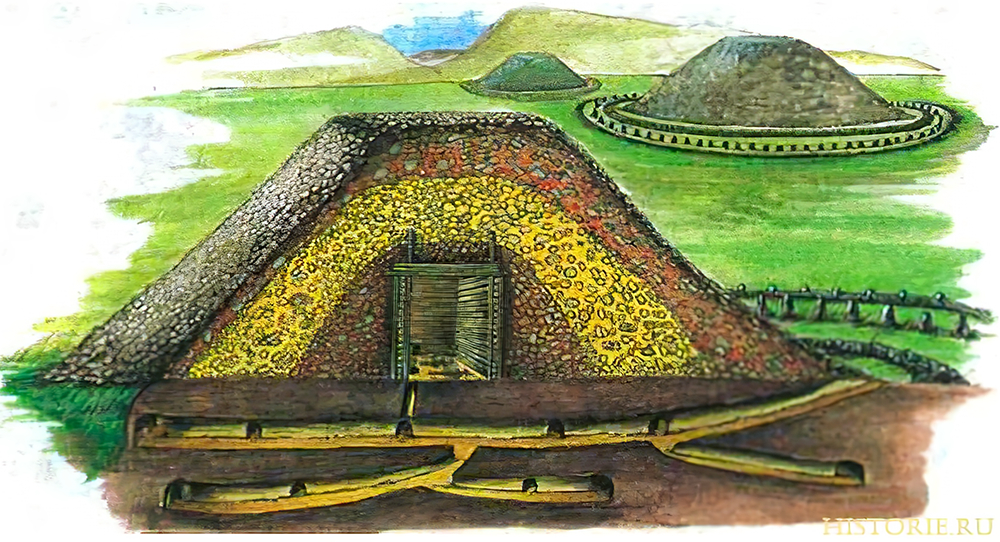
Scythian burial mound in cross section
( Note that the burial mounds of the Rossosh area were built by the ancestors of the Scythians.
The Scythian culture was based on that of those who built the Rossosh area burial mounds - Don )
Photo: http://www.historie.ru/civilizacii/skify/115-skifskie-kurgany.html

This good photograph is included to demonstrate the typical method of excavating Kurgans, in slices through the mound.
Barsuchiy Log kurgan, located 35 km north of Abakan and not far from Salbyk. Sections through the kurgan, 2004.
Although excavations have been conducted in the Minusinsk Basin for almost 300 years, this was the first time that one of the monumental burial complexes of the Tagar culture of the Scythian period was investigated with modern excavation and documentation materials. The Barsuchiy Log kurgan, still circa 10 metres in height, is a peculiarity among Eurasian large kurgans due to its pyramidal shape. In addition, it has a circa 55 m × 55 m large enclosure with an entrance in the east, built of massive stone slabs, a characteristic feature of the Tagar culture in this region. Investigations revealed that the kurgan was built of grass sod, as was likely the case with the large mound in Salbyk. However, the outer mantle of the Barsuchiy Log kurgan consisted of orange-red clay blocks; thus, it was visible from afar in the steppe as a red pyramid.
Photo and text: Parzinger (2017)
References
- Anthony, D., 2019: Bronze Age herders of the Eurasian steppes, Archeology, http://s155239215.onlinehome.us/turkic/btn_Archeology/DAnthonyBronzeAgeEn.htm#catacomb
- Berezutsky, V., Grinev A., 2008: Rossoshansky burial mounds, Voronezh: Press Press Publishing House
- Chernykh, E., 2008: The 'Steppe Belt' of stockbreeding cultures in Eurasia during the Early Metal Age, Trabajos de Prehistoria, 65(2), July 2008, pp 73-93, ISSN: 0082-5638 DOI: 10.3989/tp.2008.08004
-
Gimbutas, M., 1961: 'Timber-graves' in Southern Russia, Expedition Magazine, 3. (1961): n. pag. Expedition Magazine. Penn Museum, 1961 Web. 23 Jun 2019
- Haarmann H., 2016: Auf den Spuren der Indoeuropäer: Von den neolithischen Steppennomaden bis zu den frühen Hochkulturen , CH Beck, 2016, 368 pp.
- Harding, A., Fokkens, H., 2013: The Oxford Handbook of the European Bronze Age, OUP Oxford, 27 Jun 2013 - Social Science - 750 pages
- Juras, A., et al., 2017: Diverse origin of mitochondrial lineages in Iron Age Black Sea Scythians, Scientific Reports, www.nature.com/scientificreports
- Lichardus, J., 1987: La protohistoire de l'Europe, 1987, Book 1 Chapter III:III.1.A
- Parzinger, H., 2017: Burial mounds of Scythian elites in the Eurasian steppe: New discoveries, Journal of the British Academy, 5, 331–355. DOI https://doi.org/10.5871/jba/005.331
- Piotrovsky, B., 1973: Early Cultures of the Lands of the Scythians, Adapted from a Russian text by Boris Piotrovsky, The State Hermitage Museum, Leningrad, https://www.metmuseum.org/pubs/bulletins/1/pdf/3269231.pdf.bannered.pdf
